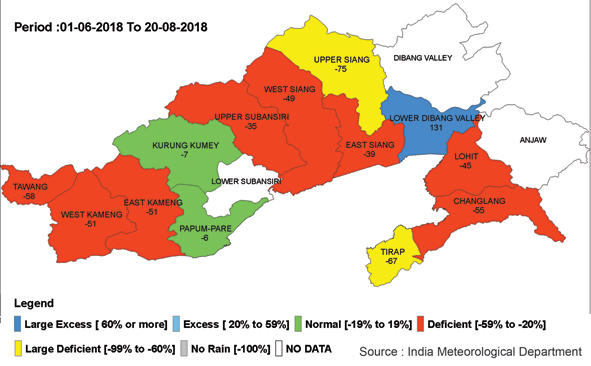[ Tongam Rina ]
ITANAGAR, Aug 20: Radha Mura is a sharecropper in Alubari in Namsai district. Like many rice farmers in the state, she is worried that there won’t be enough rice.
There is no rain, she says, almost pleading at the clear blue sky while she transplants paddy in a chapped land with her school-going daughter and a friend.
“All I need is rain, so that I am able to feed my family of six,” she says in Assamese.
She says that she depends on the rain for wet rice cultivation on a major part of the field as only half of her field has irrigation facility.

“Usually, we are done with rice transplantation way before 15 August (Independence Day), but this year, we are planting whenever it rains,” she says. “I don’t want to waste the rice seedlings, so I plant whenever there is a little rain, though I know most of it won’t survive if it doesn’t rain.

“This year, we are staring at hunger,” she says as she informs that most of her friends who depend on the rain have abandoned their fields.
“What will happen to us?” she asks.
In Koyu village in Lower Siang, Topi Koyu says that she abandoned half of her field because the stream, a major water source for her paddy field, had gone dry.
“The trees near the stream were felled, so the water source completely went dry during summer,” she says.
She depends on the rain for some portion of her paddy field. And this year, during the peak of paddy transplantation in June-July, it stopped raining altogether, she says.
“The coming year, I am going to concentrate on jhum cultivation instead of wet rice field,” she says.
The heartache of abandoning a field is too much to bear, she says.
Most paddy fields in the state are rain-fed.
T Borang, a farmer in Mebo in East Siang, says that many villagers who depend on the rain for paddy cultivation will have a difficult time.
Known as one of the rice bowls of Arunachal, Mebo is a rice self-sufficient village. “But this year many families will have to depend on rice supplied under the public distribution system (PDS),” says Borang.
Earlier, nobody in the village relied on the PDS because there always used to be enough rice for everyone, he says.
“Sometimes the villagers get rice from the PDS to make Apong (local brew), but this year, the PDS is going to be the only source of rice,” Borang says.
Even the fields with irrigation facilities will have lesser rice this year as rainwater is the best for paddy farmers, he says. That apart, he says that some irrigation canals have gone dry. Borang has irrigation facility, but he says that the paddy’s growth is not looking too promising.
Ibom Bomjen, a BJP politician-cum-landowner who relies on a share cropper for farming, says that of the 15 acres of paddy field he owns, paddy transplantation was done only on five acres of land.
“The crop is not looking good. The paddies will perhaps die,” Ibom, of Lumpo in Lower Siang, says.
He says that his area will have a massive rice shortage. Many farmers have given up halfway because of the draught-like situation, and there is no irrigation facility to speak of. Ibom has approached the department for help, but he is yet to hear from them.
This monsoon, Arunachal has witnessed a 32 percent shortfall in rain, and the farmers who depend on the rain for their paddy fields are already affected by it as many have been forced to abandon their fields.
According to government records, the total production of rice in 2017-18 was 315644.53 metric tons. The major rice producing districts are Upper Subansiri, Papum Pare, Changlang, East Siang, and Lower Dibang Valley. Most of these districts did not receive enough rainfall during the 1 June-15 August period, according to the India Meteorological Department (see pic).
Upper Siang, Tawang and Tirap had a large rain deficiency, while the rest of the districts had deficient rainfall. The two exceptions were Kurung Kumey and Papum Pare, which received normal rainfall.
In major part of the state, plantation of paddy seeds is done between May and June, while the transplantation is done between end-June to early August, when the state receives the most rainfall. The harvesting is usually done in November-December.
But the farmers fear that there won’t be much to harvest this year.


